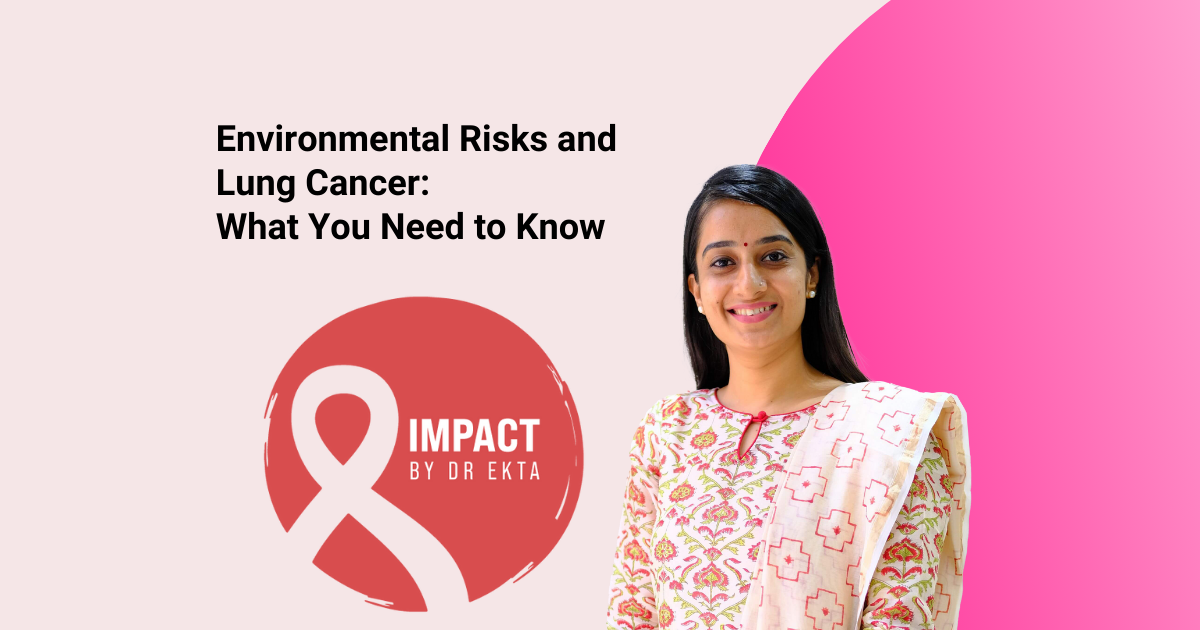One of the most common questions I hear from my patients is, “Why did this happen to me?” While smoking remains the leading cause of lung cancer, the environment around us plays a significant and often underestimated role. This blog explores how environmental risks contribute to lung cancer and what you can do to reduce your exposure.
Understanding Environmental Risks in Lung Cancer
Lung cancer doesn’t only affect smokers. A growing number of non-smokers are being diagnosed with lung cancer, and environmental factors are often to blame. From air pollution to radon exposure, these risks are all around us.
Air Pollution: The Invisible Enemy
Living in cities with high levels of air pollution can significantly increase the risk of developing lung cancer. Tiny particles in polluted air, known as PM2.5, penetrate deep into the lungs and cause cellular damage. Studies show that prolonged exposure to polluted air can lead to genetic mutations, triggering cancer.
While urbanization and industrial growth are unavoidable, there are steps you can take:
- Avoid outdoor activities during high pollution days.
- Use air purifiers in your home to reduce indoor pollution.
- Advocate for cleaner energy policies in your community.
Radon Gas: A Silent Threat
Radon is a naturally occurring radioactive gas that seeps from the ground into homes and buildings. It is the second leading cause of lung cancer after smoking, yet many people remain unaware of its dangers.
Radon testing is essential, especially if you live in areas with high radon levels. Simple test kits can detect radon, and mitigation systems can reduce exposure. While radon awareness is growing in countries like the United States, India still needs more widespread efforts to educate the public and provide affordable testing solutions.
Secondhand Smoke: A Shared Risk
Even if you don’t smoke, exposure to secondhand smoke can significantly increase your lung cancer risk. Secondhand smoke contains the same carcinogens as firsthand smoke and is responsible for many preventable lung cancer cases worldwide.
If you live with a smoker or work in an environment where smoking is prevalent, encourage smoke-free spaces and seek support for your loved ones to quit smoking.
Occupational Hazards and Lung Cancer
Certain professions expose workers to substances that increase lung cancer risk. Asbestos, for example, has been linked to both lung cancer and mesothelioma. Similarly, exposure to arsenic, diesel exhaust, and silica dust can elevate cancer risks.
If your job involves exposure to such substances, ensure that your workplace adheres to safety standards. Use protective equipment and advocate for regular health screenings.
The Role of Diesel Exhaust
Diesel exhaust, a common pollutant in urban areas, is classified as a Group 1 carcinogen by the World Health Organization. Long-term exposure, particularly for truck drivers and construction workers, can increase the risk of lung cancer. Choosing cleaner transportation options and reducing personal exposure can help mitigate this risk.
Indoor Air Pollution: Hidden Dangers in Your Home
For many households in rural and semi-urban areas, the use of solid fuels like wood, coal, or cow dung for cooking is a significant source of indoor air pollution. Prolonged exposure to smoke from these fuels can damage lung tissues and contribute to lung cancer over time.
Switching to cleaner cooking technologies, such as LPG or electric stoves, can make a huge difference. Additionally, ensuring proper ventilation in kitchens can reduce smoke inhalation.
Genetic and Environmental Interplay
Lung cancer doesn’t have a single cause. In many cases, environmental exposures interact with genetic predispositions. For instance, some people may have a higher sensitivity to air pollution or secondhand smoke due to their genetic makeup. This makes it even more important to be proactive about reducing environmental risks.
Steps to Reduce Environmental Risks
While we cannot completely eliminate our exposure to environmental risks, we can take practical steps to minimize their impact:
- Stay Informed: Awareness is the first step. Learn about common environmental risks in your area.
- Monitor Air Quality: Check air quality indexes and avoid outdoor activities on high-pollution days.
- Radon Testing: Test your home for radon, especially if you live in a high-risk region.
- Healthy Lifestyle: A balanced diet rich in antioxidants can help repair lung damage caused by environmental factors.
- Regular Screenings: If you are at higher risk due to occupational exposure or family history, consult your doctor about lung cancer screenings.
The Global Perspective on Lung Cancer and the Environment
As our understanding of lung cancer evolves, we are learning that environmental risks are just as critical as smoking cessation in preventing the disease. Governments, healthcare providers, and individuals must work together to create cleaner, safer environments.
Policy Changes and Advocacy
- Stricter regulations on industrial emissions can significantly reduce air pollution.
- Public health campaigns can raise awareness about radon testing and mitigation.
- Subsidies for clean cooking technologies can reduce indoor air pollution in rural areas.
Hope for the Future
Advances in research are giving us better tools to fight lung cancer, from targeted therapies to early detection methods. However, prevention remains the best cure. By addressing environmental risks, we can significantly reduce the burden of lung cancer on individuals and families.
Let’s strive for a cleaner, healthier world where lung cancer becomes a rarity. Together, through awareness and action, we can make it happen.

